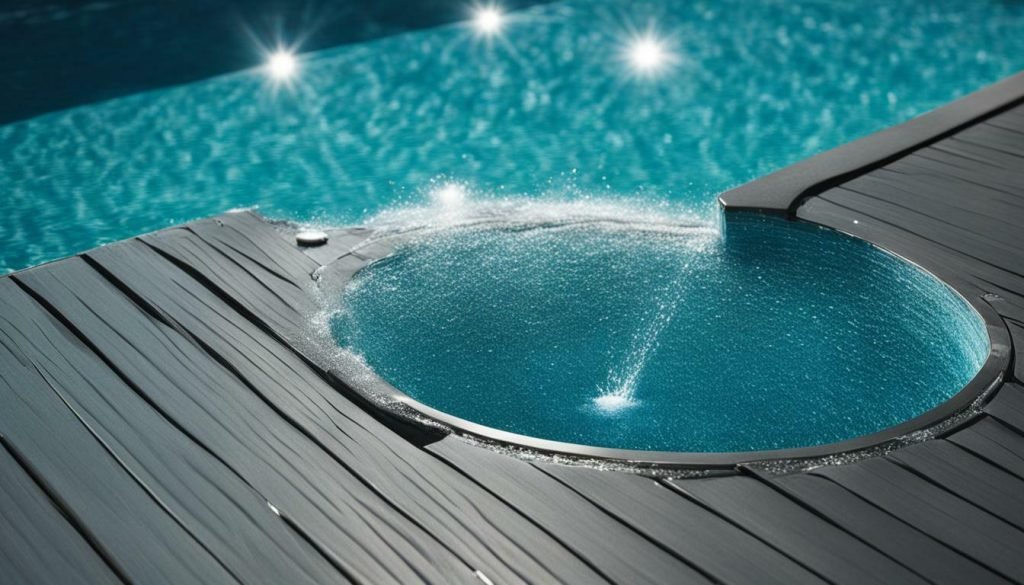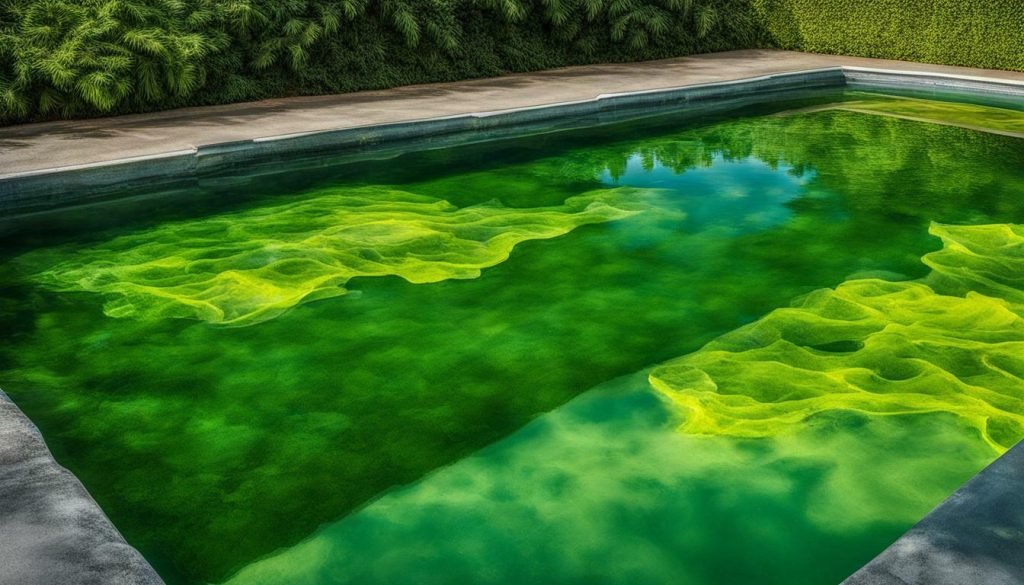Welcome to your comprehensive pool chlorination guide, where we offer expert advice and tips on maintaining optimal pool chlorine levels, proper dosing techniques, effective pool water treatment, and the benefits of using chlorine for pools. A clean and clear swimming pool is essential for your enjoyment and safety. By following the advice in this guide, you can ensure crystal clear waters that are inviting to plunge into on a hot summer’s day. Let’s dive in!
Key Takeaways
- Regular skimming, brushing, and cleaning are necessary to remove debris and algae buildup.
- Proper water circulation and filtration are essential for maintaining a clean pool.
- Maintaining a balance of chemicals like pH, chlorine, alkalinity, and calcium hardness is crucial.
- Shocking the pool with a high dose of chlorine helps eliminate contaminants.
- Superchlorination may be required to tackle persistent algae blooms.
Now that we’ve covered the basics, let’s explore each aspect of pool chlorination in detail. In the next section, we’ll delve into understanding pool chlorination and its benefits.
Understanding Pool Chlorination and Its Benefits
In this section, we delve into the world of pool chlorination, exploring its vital role in disinfecting and sanitizing pool water, and how it ensures a safer and healthier swimming environment for you and your loved ones.
When it comes to pool water disinfection and sanitization, chlorine for pools is a trusted and widely used method. Chlorine effectively eliminates harmful bacteria, viruses, and other pathogens, ensuring that your pool remains a safe space for recreation. Pool water treated with chlorine provides peace of mind, knowing that you and your family are swimming in clean and hygienic waters.
But the benefits of pool chlorination go beyond just keeping the water free from harmful organisms. Regular chlorination helps to maintain balanced water chemistry, ensuring optimal pH levels and preventing algae growth. By controlling these factors, chlorine enhances water clarity, making your pool look inviting and crystal clear.
To further emphasize the importance of pool water disinfection and sanitization, we would like to share with you a quote from Dr. John, a renowned pool expert:
“Proper pool chlorination is essential for maintaining a healthy swimming environment. It not only kills germs and harmful bacteria but also prevents the growth of algae, keeping your pool water clean, clear, and inviting.”

In summary, pool chlorination plays a crucial role in disinfecting and sanitizing pool water, providing a safer and healthier swimming experience. The benefits of chlorine for pools extend beyond just water disinfection, helping to maintain water clarity and preventing the growth of algae. By understanding the importance of pool chlorination, you can ensure that your pool remains a pristine oasis for enjoyment, relaxation, and fun.
Maintaining Proper Pool Chlorine Levels
Proper pool chlorine levels are essential for maintaining clean and clear waters. In this section, we provide guidance on how to maintain optimal chlorine levels, discuss the factors that influence chlorine levels, and offer valuable pool maintenance tips to ensure your pool stays in top condition.
One of the primary factors that affect chlorine levels in your pool is sunlight exposure. Ultraviolet (UV) rays from the sun can cause chlorine to dissipate quickly, reducing its effectiveness in keeping your pool sanitized. To minimize this, consider using a pool cover when the pool is not in use, especially during the hottest parts of the day.
Another important consideration is bather load. The number of people using the pool and their frequency of use can significantly impact chlorine levels. As more swimmers enter the pool and introduce contaminants like sweat, oil, and urine, chlorine gets depleted faster. Therefore, it is crucial to regularly test and adjust chlorine levels accordingly, ensuring they remain within the recommended range.
Pool Maintenance Tips
In addition to monitoring chlorine levels, there are several pool maintenance tips that can help maintain optimal water conditions. Firstly, regularly skimming the pool’s surface and removing debris like leaves and bugs can prevent them from decomposing and affecting chlorine levels. Furthermore, regular brushing and cleaning of the pool walls and floor can help remove algae buildup, preventing it from consuming excessive chlorine.
Proper water circulation and filtration are also vital for maintaining optimal chlorine levels. Regularly cleaning and backwashing the pool filter will ensure efficient filtration and prevent clogs that can hinder water flow. Additionally, consider running the pool pump for an adequate amount of time each day to ensure proper water circulation, allowing the chlorine to distribute evenly throughout the pool.
| Pool Maintenance Tips |
|---|
| Skim the pool’s surface regularly to remove debris |
| Brush and clean pool walls and floor to prevent algae buildup |
| Clean and backwash the pool filter regularly for efficient filtration |
| Ensure proper water circulation by running the pool pump for an adequate amount of time |
By following these pool maintenance tips and regularly monitoring and adjusting chlorine levels, you can ensure that your pool remains clean, clear, and ready for hours of fun and relaxation.

The Importance of Pool Water Treatment
A crucial aspect of pool maintenance is effective water treatment. In this section, we explore the importance of proper water circulation, filtration, and the essential role of chemical balance in maintaining pristine pool waters.

Proper water circulation ensures that the pool water remains clean and free from impurities. It helps distribute chemicals evenly, prevents stagnant areas, and discourages the growth of algae and bacteria. An efficient filtration system is equally vital in removing debris, dirt, and small particles that can cloud the water. Regularly cleaning the pool filter ensures optimal performance and helps maintain crystal clear waters.
Chemical balance
To achieve and maintain the ideal chemical balance in your pool, it is important to regularly test and adjust the levels of key chemicals such as pH, chlorine, alkalinity, and calcium hardness. pH levels should be maintained between 7.2 and 7.8 to prevent eye and skin irritation and facilitate effective chlorine disinfection. Adequate chlorine levels help kill bacteria and prevent the growth of algae, ensuring your pool remains safe for swimming. Proper alkalinity and calcium hardness levels help maintain water balance and protect pool surfaces from corrosion or scale buildup.
| Chemical | Ideal Level | Test Frequency |
|---|---|---|
| pH | 7.2 – 7.8 | Weekly |
| Chlorine | 1 – 3 ppm | Daily |
| Alkalinity | 80 – 120 ppm | Monthly |
| Calcium Hardness | 200 – 400 ppm | Monthly |
Regularly monitoring and adjusting these chemical levels will help maintain the effectiveness of your pool water treatment. It is recommended to use reliable pool water testing kits and consult a pool professional if you need assistance in maintaining the proper chemical balance.
By ensuring proper water circulation, filtration, and chemical balance, you can enjoy a clean and inviting swimming pool all year round. Remember to stay consistent with your pool maintenance routine to keep your pool water in optimal condition and provide a safe and enjoyable swimming experience for you and your family.
Shocking the Pool – Eliminating Contaminants with Chlorine
Shocking the pool with a powerful dose of chlorine is a vital step in preventing and eliminating contaminants. In this section, we delve into the technique of shocking the pool, providing guidance on when and how to do it effectively, along with the advantages of using chlorine tablets for dosing.
When it comes to maintaining a clean and clear swimming pool, regular chlorination alone may not be enough to ensure optimal water quality. This is where shocking the pool comes in. Shocking involves adding a high concentration of chlorine to your pool water, which helps destroy bacteria, algae, and other harmful contaminants that regular chlorination might not fully eliminate.
To shock your pool effectively, it’s important to determine the right time and dosage. Most experts recommend shocking the pool once a week or whenever necessary to address specific issues such as cloudy water or an algae outbreak. The dosage will depend on the size of your pool and the chlorine levels needed. Chlorine tablets are a convenient option for dosing, as they are pre-measured and dissolve slowly, providing a controlled release of chlorine over time.
Using chlorine tablets for shocking not only simplifies the process but also ensures a consistent and steady release of chlorine, resulting in more efficient water disinfection. By following the manufacturer’s instructions, you can easily calculate the number of tablets needed based on your pool size. Remember to always handle chlorine products with care and to follow safety guidelines.
| Advantages of Chlorine Tablets for Shocking the Pool: |
|---|
| 1. Convenient and easy to use. |
| 2. Controlled release of chlorine. |
| 3. Ensures consistent water disinfection. |
| 4. Reduces the risk of over-chlorinating. |
| 5. Helps maintain stable chlorine levels. |
By regularly shocking your pool with chlorine tablets, you can effectively eliminate contaminants, promote a healthier swimming environment, and enjoy crystal clear waters all season long.
Expert Tip:
“When shocking your pool, it’s important to test the water’s chlorine levels beforehand. This will help you determine the appropriate dosage needed to achieve the desired shock treatment. Additionally, it’s recommended to shock the pool in the evening or at night, when the sun’s UV rays are less active, allowing the chlorine to work more effectively.”

Remember, maintaining a pristine pool requires consistent care and attention. In the next section, we will discuss how to tackle persistent algae blooms through superchlorination techniques.
Tackling Persistent Algae Blooms – Superchlorination Techniques
Dealing with persistent algae blooms can be challenging, but superchlorination offers an effective solution. In this section, we discuss the superchlorination technique, its effectiveness in combating algae, and provide essential maintenance tips to prevent future bloom occurrences.
Superchlorination, also known as shock chlorination, involves adding a highly concentrated dose of chlorine to the pool water. This technique destroys algae and other organic contaminants, restoring the pool to its pristine condition. To superchlorinate your pool, start by testing the water’s chlorine level. It is crucial to ensure that the chlorine level is below 5 ppm before adding the shock treatment.
Once you have confirmed the chlorine level, carefully follow the manufacturer’s instructions on the shock treatment product. Wear protective gloves and eyewear, and never mix different types of chlorine products. Add the shock treatment to the pool water in the evening or during cloudy weather to minimize chlorine loss due to sunlight. Start at one end of the pool and distribute the shock treatment evenly, using a pool brush if necessary to help dissolve the granules.
After superchlorinating the pool, allow the water to circulate for at least 8-10 hours or overnight. This will ensure that the chlorine is evenly distributed and has ample time to eliminate algae and other contaminants. Remember to retest the chlorine level after the recommended time has elapsed. If necessary, add additional chlorine to reach a safe level of 1-3 ppm.

Maintenance Tips to Prevent Future Algae Blooms
Superchlorination is an effective one-time solution for algae blooms, but preventing future occurrences requires consistent maintenance. Here are some essential tips to keep algae at bay:
- Regularly test and adjust the pool’s chlorine levels to ensure proper sanitation. Aim for a range of 1-3 ppm.
- Keep the pool water balanced by monitoring and adjusting pH, alkalinity, and calcium hardness levels regularly.
- Skim the pool surface daily to remove leaves, debris, and other organic matter that can contribute to algae growth.
- Brush the walls and floor of the pool weekly to dislodge any algae or biofilm buildup.
- Ensure proper water circulation by running the pool pump for 6-8 hours each day.
- Regularly clean and maintain the pool filter to keep it free from debris and functioning optimally.
By following these maintenance tips and employing the superchlorination technique when needed, you can enjoy a clean and algae-free swimming pool throughout the year. Consistency is key in maintaining a pristine pool that provides hours of fun and relaxation.
| Section | Content |
|---|---|
| Section 1 | Your Comprehensive Pool Chlorination Guide – Maintain Crystal Clear Waters |
| Section 2 | Understanding Pool Chlorination and Its Benefits |
| Section 3 | Maintaining Proper Pool Chlorine Levels |
| Section 4 | The Importance of Pool Water Treatment |
| Section 5 | Shocking the Pool – Eliminating Contaminants with Chlorine |
| Section 6 | Tackling Persistent Algae Blooms – Superchlorination Techniques |
| Section 7 | The Importance of Regular Pool Filter Cleaning |
The Importance of Regular Pool Filter Cleaning
Proper pool filter maintenance plays a crucial role in maintaining optimal water circulation and filtration. In this section, we guide you through the process of regular pool filter cleaning, offering step-by-step instructions and highlighting the importance of a clean filter for clear and healthy pool waters.
To begin, gather the necessary tools: a pool brush, a skimmer net, and a garden hose. Start by skimming the surface of the pool to remove any debris like leaves or insects. This prevents clogging of the filter and ensures proper water flow. Next, use the pool brush to scrub the sides and bottom of the pool to dislodge any algae or sediment buildup. This step further helps in preventing the filter from getting clogged.
Once the surface is skimmed and the walls are brushed, it’s time to clean the pool filter. The type of filter you have will determine the cleaning process. For a sand filter, turn off the pool pump and set the filter valve to ‘backwash.’ Turn on the pump and let it run until the water in the sight glass or discharge hose appears clear. Once clear, turn off the pump and set the valve to ‘rinse.’ Run the pump for a few minutes to flush out any remaining debris. For cartridge filters, remove the cartridges and rinse them thoroughly with a garden hose to remove dirt and debris. For DE filters, backwash and recharge the filter according to the manufacturer’s instructions.
| Filter Type | Cleaning Process |
|---|---|
| Sand Filter | Backwash and rinse |
| Cartridge Filter | Remove and rinse with a garden hose |
| DE Filter | Backwash and recharge |
Remember, a clean filter is essential for effective water circulation and filtration in your pool. Neglecting filter maintenance can lead to reduced water flow, increased energy consumption, and poor water quality. By following these simple steps and regularly cleaning your pool filter, you can ensure that your pool stays clear, healthy, and ready for hours of fun and relaxation.

Congratulations, you have reached the end of our comprehensive pool chlorination guide.
By following the tips and techniques discussed throughout this guide, you can ensure crystal clear waters in your swimming pool and create a safe and enjoyable swimming experience for you and your loved ones.
Maintaining a clean and clear swimming pool requires regular skimming, brushing, and cleaning to remove debris and algae buildup. Proper water circulation and filtration are essential, along with maintaining a balance of chemicals such as pH, chlorine, alkalinity, and calcium hardness.
Shocking the pool with a high dose of chlorine can help eliminate contaminants, and superchlorination may be necessary for persistent algae blooms. Cleaning the pool filter regularly is important for optimal water circulation and filtration. Winterizing the pool is crucial in areas with distinct seasons, while additional maintenance tasks may be necessary during warmer months.
Consistency is key in maintaining a pristine pool that provides hours of fun and relaxation. By implementing the pool maintenance tips provided in this guide, you can enjoy crystal clear waters and a swimming pool that is always ready for a refreshing dip.
FAQ
What are the essential tasks for maintaining a clean swimming pool?
The essential tasks for maintaining a clean swimming pool include regular skimming, brushing, and cleaning to remove debris and algae buildup. Proper water circulation and filtration are important, as is maintaining a balance of chemicals such as pH, chlorine, alkalinity, and calcium hardness.
How can I eliminate contaminants in my pool?
Shocking the pool with a high dose of chlorine can help eliminate contaminants. Superchlorination may be necessary for persistent algae blooms. It is also important to regularly clean the pool filter to ensure optimal water circulation and filtration.
What steps should I take to winterize my pool?
Winterizing the pool is crucial in areas with distinct seasons. This involves lowering the water level, draining the plumbing lines, and adding a winterizing chemical treatment. Consult a professional or refer to the manufacturer’s instructions for specific steps related to your pool.
Are there additional maintenance tasks required during warmer months?
Yes, during warmer months, it is recommended to regularly monitor and adjust chemical levels, clean and skim the pool more frequently, and regularly inspect and maintain pool equipment such as pumps and filters. Consistency is key in maintaining a pristine pool.
